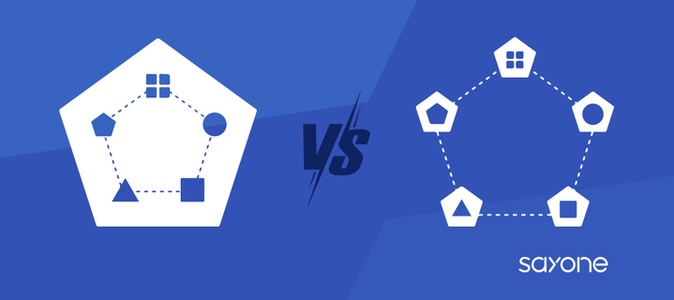Microservices vs Monolithic: Which to Choose ?

Share This Article
Migrating Your Application from Monolithic to Microservices Architecture
Table of Contents
Subscribe to Our Blog
We're committed to your privacy. SayOne uses the information you provide to us to contact you about our relevant content, products, and services. check out our privacy policy.
Selecting the appropriate architecture is vital for any business, as it lays the foundation for system scalability, flexibility, and overall success. In the debate between monolithic and microservices architectures, understanding their differences and their implications on development, maintenance, and growth is essential. This blog explores the importance of choosing the right architecture for your business, examining the benefits and considerations of both 'monolithic' and 'microservices' approaches.
Understanding Microservices Architecture
Microservices architecture is an approach to software development that structures an application as a collection of small, loosely coupled services. Each service is responsible for a specific business capability and can be developed, deployed, and scaled independently. This architectural style promotes 'modularity,' 'flexibility,' and scalability,' enabling organizations to build complex systems in a more 'agile' and efficient manner.
Advantages of Microservices:
- Scalability: Microservices allow for independent scaling of different services based on their specific needs, enabling efficient resource utilization.
- Flexibility: Services can be developed and deployed independently, allowing teams to work in parallel and adopt different technologies or frameworks as needed.
- Fault Isolation: If one service fails, it doesn't affect the entire application. The fault is isolated to that specific service, reducing the impact on the overall system.
- Continuous Deployment: Microservices support continuous integration and deployment practices, enabling faster delivery of new features and updates.
- Ecosystem of Diverse Technologies: Each service can use the most appropriate technology stack for its specific requirements, fostering innovation and flexibility within the development teams.
Disadvantages of Microservices:
- Increased Complexity: Managing a distributed system of interconnected services introduces additional complexity, requiring robust service discovery, communication, and coordination mechanisms.
- Operational Overhead: Deploying and monitoring multiple services can be more challenging than managing a monolithic application, requiring effective infrastructure and orchestration tools.
- Network Communication: Inter-service communication introduces network latency and potential failure points, which must be carefully addressed.
- Data Management: Maintaining data consistency across different services can be complex, often requiring the implementation of distributed transactions or event-driven architectures.
Understanding Monolithic Architecture
Monolithic architecture refers to a traditional approach where an entire application is built as a single, self-contained unit. In this architecture, all components and functionalities of the application are tightly integrated, typically running on a single codebase and sharing the same memory space.
Advantages of Monolithic Architecture:
- Simplicity: The development process is straightforward, as the application is built as a single entity.
- Easier deployment: Deploying a monolithic application involves deploying a single artifact, simplifying the deployment process.
- Simpler debugging: Debugging is generally easier in monolithic applications since all code components are within the same codebase.
Disadvantages of Monolithic Architecture:
- Scalability: Scaling a monolithic application can be challenging as the entire application needs to be scaled together, even if only specific components require additional resources.
- Flexibility: Making changes or introducing new technologies may be difficult, as modifications often impact the entire application.
- Maintenance overhead: Monolithic architectures can become complex and challenging to maintain, especially as the application grows in size and complexity.
- Limited fault isolation: Issues in one component can impact the entire application, leading to potential system-wide failures.
Factors to Consider when Choosing an Architecture
When deciding between a monolithic and microservices architecture for your business, several factors should be taken into consideration to ensure the best fit for your specific needs. These factors include:
Business requirements and goals: It's crucial to align your architectural choice with your business objectives. For instance, if you anticipate frequent changes in functionality or plan to scale rapidly, a microservices architecture may be more suitable. On the other hand, if your requirements are relatively stable and simplicity is a priority, a monolithic architecture might be a better fit.
Checkout Top 6 Microservices Trends to Take Note of in 2023
Team size and organizational structure: The size and structure of your development team play a significant role in architecture selection. Microservices architecture empowers large teams to work on independent components, promoting faster development cycles and allowing for parallel work. Conversely, monolithic architecture can be more manageable for smaller teams with less complex coordination requirements.
Scalability and performance needs: Consider your application's scalability requirements. Microservices architecture offers inherent scalability advantages by allowing you to scale individual services independently based on demand. Monolithic architecture, while generally more challenging to scale, can still handle moderate workloads efficiently.
Development speed and agility: If speed and agility are essential for your business, microservices architecture shines. It enables faster development cycles as teams can work independently on different services without affecting others. However, if development speed is not a top priority, monolithic architecture may offer simplicity and quicker initial setup.
Maintenance and operational overhead: Assess your application's long-term maintenance and operational requirements. Microservices architecture requires additional effort to manage the distributed nature of services, handle inter-service communication, and ensure fault tolerance. Monolithic architecture, in comparison, has a lower operational overhead due to its centralized nature.
Cost considerations: Both architectural approaches have cost implications. Microservices architecture typically requires more investment in infrastructure, monitoring, and communication mechanisms. Monolithic architecture, on the other hand, may require higher upfront development costs. Consider your budget and weigh the cost implications against the benefits provided by each architecture.
Use Cases: When to Choose Microservices
Microservices architecture offers several advantages in specific scenarios, making it suitable for certain use cases.
Highly complex systems:
Microservices architecture is beneficial for businesses dealing with highly complex systems, such as enterprise applications with multiple interconnected components. By breaking down the system into smaller, independent services, development teams can focus on specific functionalities, resulting in better manageability and scalability.
Checkout the detailed guide on Understanding Problems with the Monolithic Architecture style
Large development teams:
When working with large development teams, microservices architecture can provide advantages. The modular nature of microservices allows teams to work on different services simultaneously, enabling parallel development and faster time to market. Additionally, each team can have ownership over specific services, enhancing productivity and accountability.
Need for independent scalability:
Microservices architecture shines when scalability is a critical requirement. Businesses experiencing variable demand across different services can independently scale the relevant microservices without affecting the entire system. This flexibility ensures efficient resource utilization and cost optimization.
Continuous deployment and integration:
Microservices architecture aligns well with continuous deployment and integration practices. With smaller and decoupled services, adopting agile development methodologies and implementing frequent updates without disrupting the entire system becomes easier. Each service can be independently tested, deployed, and integrated, enabling faster iterations.
When to Choose Monolithic Architecture
Monolithic architecture is still a viable choice in certain scenarios, offering simplicity and efficiency for specific types of applications. Let's explore some use cases where opting for a monolithic architecture might be the best decision for your business.
Simpler applications with fewer components:
Monolithic architecture is well-suited for applications with relatively straightforward functionality and a limited number of components. When your application doesn't require extensive scalability or complex interactions between various services, a monolithic approach can simplify development and maintenance efforts.
Small development teams:
A monolithic architecture can streamline the development process for businesses with limited resources and small development teams. With fewer components and services to manage, it reduces developers' complexity and learning curve, enabling them to focus on building features and delivering value quickly.
Checkout How Netflix uses Microservices Architecture Efficiently
Tight coupling and interdependencies:
In some cases, tight coupling between different modules or components of an application is inevitable. If your application heavily relies on shared libraries, database schemas, or tightly integrated functionalities, a monolithic architecture can provide a more straightforward approach to managing dependencies and ensuring seamless communication between modules.
Best Practices for Implementing Microservices or Monolithic Architecture
Design principles and patterns play a crucial role in the successful implementation of both microservices and monolithic architectures. Our expert web developers highlight the following key considerations when choosing an architecture for your business:
Design principles and patterns:
- For microservices architecture, the use of domain-driven design (DDD) can help identify bounded contexts and define clear service boundaries.
- Applying the single responsibility principle ensures that each microservice has a specific and well-defined purpose.
- 'Event-driven architecture' (EDA) and message queues facilitate loose coupling and enable asynchronous communication between microservices.
- Monolithic architecture benefits from modular design principles, such as separating components based on functionality or layers, to promote maintainability.
- Communication and data management strategies are also vital for effective implementation;
Communication and data management strategies:
- Microservices architecture relies on lightweight communication protocols like REST or messaging queues to facilitate inter-service communication.
- Implementing 'API gateways' and service registries allows for centralized service discovery and routing in a microservices environment.
- 'Monolithic architecture' emphasizes tight coupling, enabling direct communication between components within the application.
- Using a shared database or implementing data replication mechanisms can facilitate data consistency in a monolithic architecture.
- Testing and monitoring approaches are essential to ensure the stability and reliability of both architectures.
Testing and monitoring approaches:
In a microservices architecture implementing 'unit tests,' 'integration tests,' and 'contract tests' helps ensure individual service functionality and compatibility.. Here is a complete guide on How to test Microservices
Applying 'chaos engineering' techniques, such as fault injection, can validate the resilience of microservices under stressful conditions.
Monolithic architecture benefits from 'comprehensive regression' testing to ensure the stability of the entire application.
Implementing centralized logging, monitoring, and alerting systems enables effective performance monitoring and issue resolution in both architectures.
Case Study Note: We successfully developed a web application for Etail Pet, utilizing microservices architecture and a 'multi-tenant' approach. The primary objective was to ensure optimal system performance, even under high web traffic conditions. By implementing microservices, we achieved better scalability and independent deployment of services, allowing us to handle the large volume of product, inventory, and user data efficiently.
Conclusion:
While the choice between monolithic and microservices architecture depends on specific business needs, microservices prove valuable as organizations grow and application demands intensify. Embracing the trend of distributed architectures, 'SayoneTech' specializes in assisting companies in effectively managing the complexity and scalability of microservices. Contact our experts for comprehensive support, from technology consulting to system management, throughout your microservices adoption journey.
Share This Article
Subscribe to Our Blog
We're committed to your privacy. SayOne uses the information you provide to us to contact you about our relevant content, products, and services. check out our privacy policy.
Related Articles

Microservice Architecture
A Complete Guide For Microservices Vs. Monolithic Architectures

